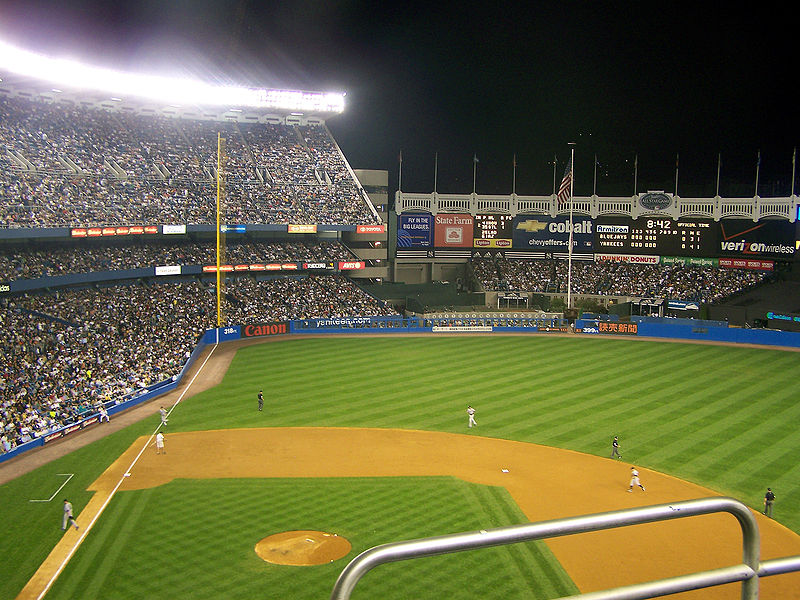Yankee Stadium
New York City
Welcome to our New York City Photo Gallery. Yankee Stadium was home to the New York Yankees from 1923 to 2008.
|
1 : 2 : 3 : 4 : 5 : 6 : 7 : 8 : 9 : 10 : 11 : 12 : 13 : 14 : 15 |
Home > New York State Photographs > Yankee Stadium
Yankee Stadium is a baseball park located in Concourse, Bronx, New York City. It is the home field for the New York Yankees of Major League Baseball (MLB) and New York City FC of Major League Soccer (MLS), as well as being the host stadium for the annual Pinstripe Bowl game. The $2.3 billion stadium, built with $1.2 billion in public subsidies, replaced the original Yankee Stadium in 2009 and is the second largest stadium in MLB by seating capacity. It is located one block north of the original, on the 24-acre (9.7 ha) former site of Macombs Dam Park; the 8-acre (3.2 ha) site of the original stadium is now a public park called Heritage Field.
The stadium incorporates replicas of some design elements from the original Yankee Stadium, and like its predecessor, it has hosted additional events, including college football games, soccer matches, two outdoor NHL games, and concerts. Although Yankee Stadium's construction began in August 2006, the project spanned many years and faced many controversies, including the high public cost and the loss of public parkland. The $1.5 billion price tag makes the new Yankee Stadium one of the most expensive stadiums ever built.

Planning
New York Yankees owner George Steinbrenner began campaigning for a new stadium in the early 1980s, just a few years after the remodeled Yankee Stadium opened. Steinbrenner at the time was reportedly considering a move to the Meadowlands Sports Complex in New Jersey. New Jersey Governor Thomas Kean in 1984 authorized the use of land for a new baseball stadium in the Meadowlands, but the state legislature did not provide financing for the stadium. In a statewide referendum in 1987, New Jersey taxpayers rejected $185 million in public financing for a baseball stadium for the Yankees. Despite the rejection from New Jersey, Steinbrenner frequently threatened to move as leverage in negotiations with New York City.
In 1988, Mayor Ed Koch agreed to have city taxpayers spend $90 million on a second renovation of Yankee Stadium that included luxury boxes and restaurants inside the stadium and parking garages and traffic improvements outside. Steinbrenner agreed in principle, but then backed out of the deal. In 1993, Mayor David Dinkins expanded on Koch's proposal by offering his Bronx Center vision for the neighborhood, including new housing, a new courthouse, and relocating the Police Academy nearby.
In 1993, New York Governor Mario Cuomo proposed using the West Side Yard, a 30-acre (12 ha) rail yard along the West Side of Manhattan and owned by the Metropolitan Transportation Authority, as the location for a new stadium for the Yankees. However, Cuomo lost his re-election bid a few months later. By 1995, Steinbrenner had rejected 13 proposals to keep the Yankees in the Bronx.
In 1998, Bronx Borough President Fernando Ferrer proposed spending $600 million in public money to add dozens of luxury boxes to the stadium, to improve highway and public transportation access, and to create a Yankee Village, with shops, restaurants, and a museum. Steinbrenner rejected this as well. That same year, Mayor Rudy Giuliani unveiled a plan to relocate the Yankees to the West Side Yard for a $1 billion stadium. However, with most of the funding coming from taxpayers, Giuliani tabled the proposal, fearing rejection in a citywide referendum. The West Side Stadium plan resurfaced in December 2001, and by January 2002, months after the September 11 attacks, Giuliani announced "tentative agreements" for both the New York Yankees and New York Mets to build new stadiums. He estimated that both stadiums would cost $2 billion, with city and state taxpayers contributing $1.2 billion.
Michael Bloomberg, who succeeded Giuliani as mayor in 2002, called the former mayor's agreements "corporate welfare" and exercised the escape clause in the agreements to back out of both deals, saying that the city could not afford to build new stadiums for the Yankees and Mets. Bloomberg said that Giuliani had inserted a clause in this deal that loosened the teams' leases with the city and would allow the Yankees and Mets to leave the city on 60 days' notice to find a new home elsewhere if the city backed out of the agreement. At the time, Bloomberg said that publicly funded stadiums were a poor investment. Bloomberg's blueprint for the stadium was unveiled in 2004, at the same time as the plan for the Mets' new stadium, Citi Field. The final cost for the two stadiums was more than $3.1 billion; taxpayer subsidies accounted for $1.8 billion.......


